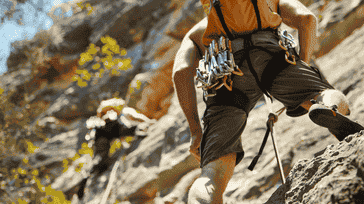Rock Climbing Etiquette Courtesies on the Wall

Rock climbing is a physically and mentally demanding sport that can be enjoyed by people of all ages. While it is an individual sport, it is also a social activity that requires climbers to interact with each other and the environment. In order to ensure a positive and safe experience for everyone, it is important to follow certain etiquette guidelines. This article will discuss some of the key principles of rock climbing etiquette, including respecting the crag, being aware of other climbers, communicating effectively, and leaving no trace. By following these guidelines, you can help to ensure that you and others have a positive and enjoyable experience while rock climbing.
Respect the crag
Respect for the climbing community is another vital aspect. This includes being courteous and considerate of other climbers, respecting their space and climbing style. Climbers should also be open to sharing knowledge, tips, and experiences to foster a positive and supportive environment. Maintaining a friendly and welcoming atmosphere enhances the overall climbing experience for everyone.
Lastly, it’s imperative to leave no trace when departing from the crag. This involves properly disposing of all waste, including food scraps, water bottles, and climbing gear. Climbers should also strive to restore the area to its natural state by replacing any rocks or vegetation that may have been disturbed during their climb. By embracing these responsible practices, climbers can ensure the preservation of the crag and minimize their ecological footprint, allowing future generations to enjoy the sport in harmony with nature.
Climber etiquette

Safety first
Before setting foot on the rock, safety should be every climber’s number one priority. This starts with ensuring that all of your gear is in good condition and that you have the necessary equipment for the climb. When in doubt, it’s better to err on the side of caution and bring more gear than you think you’ll need.
Another important safety precaution is ensuring that you are physically fit for the climb. This means being able to handle the physical demands of the climb, such as pulling yourself up the rock and maintaining a secure grip. If you have any doubts about your physical fitness, it’s best to consult with a doctor before attempting the climb.
The weather can change rapidly in mountain areas, so it’s important to be aware of the weather conditions before you start your climb. If there is any chance of rain, lightning, or high winds, it’s best to postpone your climb until the weather improves.
Climbing alone is not recommended, as it can be dangerous if you get into trouble. If you do choose to climb alone, be sure to let someone know where you’re going and when you expect to be back. It’s also a good idea to carry a first aid kit in case of emergencies.
Following these safety precautions can help you reduce the risk of accidents and injuries, allowing you to enjoy your climb without worry.
Communicate effectively

Before embarking on a climb, it is crucial to announce your intentions clearly and audibly. This serves as a heads-up to other climbers in the vicinity, alerting them to your presence and impending ascent. This simple act minimizes the risk of collisions and allows fellow climbers to adjust their own plans accordingly.
Another important aspect of communication while rock climbing is providing a warning before dropping ropes. Loose ropes pose a significant hazard, and failing to give adequate notice can result in serious accidents. A simple shout of "rope!" or "heads up!" suffices in conveying your intentions and ensuring the safety of those below.
In situations where you need to cross over other climbers, it is polite and respectful to ask for permission first. This demonstrates consideration for their safety and climbing experience, fostering a positive atmosphere on the crag. A simple gesture or verbal query, such as "Can I pass?" or "Is it okay if I cross?", can make all the difference in maintaining a harmonious climbing environment.
Lastly, the use of hand signals plays a vital role in effective communication on the rock. These signals convey a range of messages, from indicating the need for slack to requesting a belay. Familiarizing yourself with these hand signals and using them appropriately enhances safety and streamlines communication, enabling climbers to work together efficiently and avoid confusion.